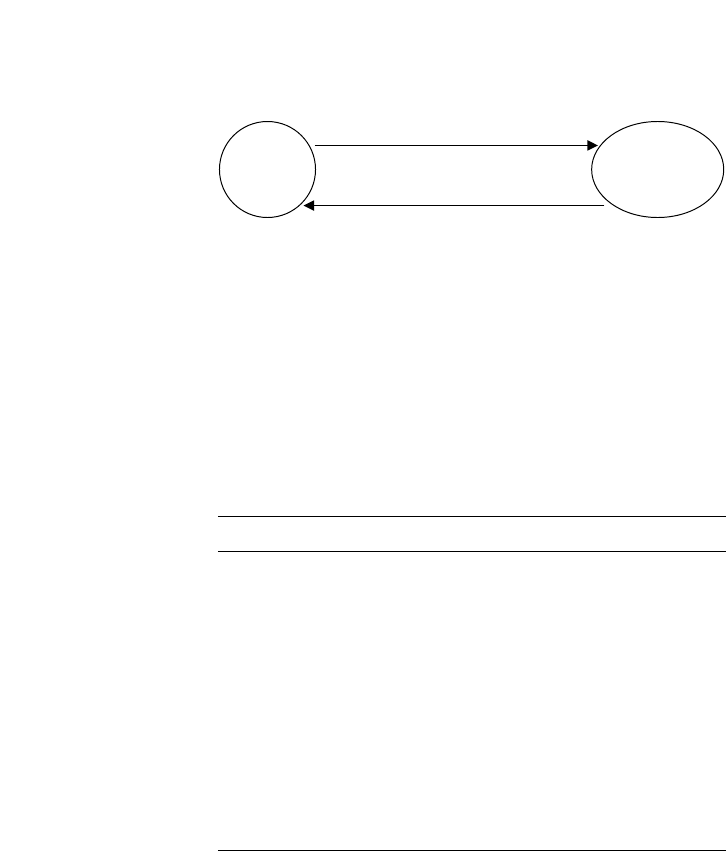As we can see, one contract, the bond future, has a delivery standard
that requires physical delivery of a bond that is on the list of deliver-
able bonds published by the exchange, whilst the other contract, the
index future, is cash-settled with reference to an exchange published
price. Notice also how the bond future specification has been subject
to changes.
More details about the contract terms and administration terms
are contained in the full contract specification, the above examples
being ‘summary’ specifications, and a copy of the specification for the
FTSE 100 Index Future is contained in the Appendices.
Standardised products that are traded on exchanges are devel-
oped by the exchange to meet perceived requirements of the
exchange members and their clients. OTC derivatives are developed
by firms to meet the need of their clients or even the specific
requirement of a single client. Fundamental differences exist
between the exchange-traded and the OTC derivatives products
including the counterparty risk situation, liquidity, suitability and
costs. Another key area where significant differences occur is in the
settlement process.
Settlement terms for exchange-traded products are set out by the
clearing house of the exchange concerned and the clearing member
is subject to many disciplines including the time of payment of obli-
gations, delivery and managing the settlement process with their
clients. Any failure to meet the disciplines successfully can cause
significant problems and may even result in the clearing member
being put into a default by the clearing house, usually terminal for
the firm.
Over-the-counter derivatives are different in the sense that the set-
tlement terms are negotiated along with the rest of the terms of the
transaction. Although some settlement terms are based on the market
standard or convention for the product concerned, the two parties to a
trade can negotiate quite different terms if needed. For example, in an
interest rate swap where two parties agree to exchange the fixed and
floating interest flows, resets will take place when the rates will be
confirmed and the settlement then takes place based on those agreed
and confirmed rates. The two parties could agree to do this every quar-
ter, semi-annually, annually or they could reset the floating rate quar-
terly and the fixed rate annually or any other combination that suits
both parties. They would also need to agree on the reference standard
for the floating rate, in the above example, if the reset was semi-
annual, maybe the 6-Month London Inter Bank Offered Rate (LIBOR)
(Figure 2.1).
20 Clearing and settlement of derivatives

The terms are negotiated and a confirmation detailing the terms is
then exchanged and should be agreed. An Interest Rate Swap (IRS)
confirmation for a fixed/floating transaction would contain informa-
tion such as:
Confirmation from mega bank To: Interbank Inc.
Interest rate swaps
Transaction date 19 June 2004
Effective date 21 June 2004
Maturity date 21 December 2004
Terms ISDA
Currency/Amount USD 5 000 000
We pay 5.76%
Frequency Annual
Calculation basis Actual/365
We receive 6-Month LIBOR
Frequency Semi-annual
Calculation basis Actual/360
There are other pieces of information that can or will be added to this
such as frequency being modified following convention.
In contrast, an exchange-traded option will have predetermined
exercise procedures; however, with an off-exchange option these
will be negotiated and could be variable. For example, a Bermudan
style option will have exercise rights at periodic times agreed by
the two parties whereas for an exchange-traded call option the
exercise rights are set out in the contract specification and apply
uniformly to all the contracts. In the latter there is no room for
argument between parties whereas that is not true of the former
where one party’s ‘understanding’ of the terms may differ from the
others.
Derivative products 21
Bank
A
Corporate
B
Pays fixed Receives fixed
Receives LIBOR Pays LIBOR
Figure 2.1 Example Interest Rate Swap

We can look at some of the characteristics and differences between
products by looking at the table below:
Product Exchange OTC Liquidity Liquidity Duration
traded exchange OTC
Interest Yes – swap Yes – usually Good in 2–50 years
rate futures, in amounts ‘common’ OTC
swap contract of £50 000 durations
size or $100 000 and type
typically £ or greater of swap
Bond Yes – contract Not usually Can range N/A Nine months
futures size varies from
Liffe Long excellent
Gilt is to poor.
£100 000, Eurobund
CBOT US on Eurex
Treasury can trade
Bond is $ around
and the Eurex a million
Eurobund is € contracts
per day
Property No Yes N/A Few Negotiable
derivatives participants
and depends
on the type
of product
required
Stock Yes Yes Good but Good in ETD, from
options equally some nine
can be stocks months
poor in and to
some low baskets 2/3 years
volatility of stocks
stocks
and
markets
There are many other differences and even quirks associated with
derivative products, some driven by the underlying on which the
derivative is based or the broad market conventions, or local market
practices and, in the case of OTC derivatives, the client needs.
So, for example, we have forward swaps that have terms agreed
today but that will not take effect for maybe 20 years, currency options
on an exchange rate between two currencies but settled in a different
currency and weather derivatives where the delivery is a compensating
monetary amount, not the underlying weather!
22 Clearing and settlement of derivatives

Standard derivative products are where there is either a standard-
ised contract or a negotiated but common structure, sometimes called
‘vanilla’ products and examples would be:
• Futures
• Forwards
• Traded options
• Interest rate swaps
• Currency swaps
• Call and put options.
More specialist derivative products are where there are very bespoke
terms or complex structures involved; sometimes these are called
‘exotic’ products, and examples would be:
• Caps, floors, collars
• Barriers (Knock in/Knock out options)
• Amortising swaps
• Forward swaps
• ‘Asian’ style or Average price options.
These products and the terminology is covered in more detail in other
chapters of the book.
It should be noted that although there may be different complexi-
ties in the structure of the products it does not always follow that
there is any particular complexity in the settlement or accounting
for these products. For example, an ‘exotic’ option will often have a
premium that is paid by the buyer in exactly the same way as a
conventional call or put option has a premium that is paid by the
buyer.
The exercise rights attached to the option may however be different
and a particular trigger may cause the exercise, delivery or even ter-
mination of the option.
Exchange-traded options have contract specifications determined
by the exchange and an example is shown below:
Euronext.liffe Individual Equity Option Contracts
Unit of Trading One option normally equals rights
over 1000 shares*
Expiry Months
January Cycle (J): means the 3
nearest expiry months from Jan,
Apr, Jul, Oct cycle
Derivative products 23

February Cycle (F): means the 3
nearest expiry months from Feb,
May, Aug, Nov cycle
March Cycle (M): means the 3
nearest expiry months from Mar,
Jun, Sep, Dec cycle
Quotation Pence/share
Minimum Price Movement 0.5 pence/share (£5.00)
(Tick Size and Value) 0.25 pence/share (£2.50)**
Exercise Day Exercise by 17:20 on any busi-
ness day, extended to 18:00 for
all series on a Last Trading Day
Last Trading Day 16:30
Third Wednesday in expiry month/
Third Friday in expiry month***
Settlement Day Settlement Day is four business
days following the day of exercise/
Last Trading Day
Trading Hours 08:00–16:30
From Thursday 18 April 2002, serial contract months and further dated
quarterly months were introduced in VOD options, resulting in the extension of
the maximum expiry to two years and the addition of two serial expiry months
such that the first three calendar months are always available for trading. Further
information is available in the Vodafone enhancement information sheet.
In addition, to become effective following the Mar 03 expiry on Wednesday 19
March 2003, serial longer-dated expiry months will be introduced in the following
options: AstraZeneca plc (AZA), Aviva plc (CUA), Barclays plc (BBL), BP plc (BP),
BT Group plc (BTG), Diageo plc (GNS), GlaxoSmithKline plc (GSK), HSBC Holdings
plc (HSB), Lloyd TSB Group plc (TSB), Prudential plc (PRU), Royal Bank of
Scotland Group plc (RBS) and Shell Transport & Trading Co. plc (SHL). Full
details are available in the UK Equity Option product enhancements pages.
* Due to corporate action contract adjustments some equity options series may
have a non-standard contract size. The unusual contract sizes page contains
current details.
** The minimum price movement for the following equity options price is now
0.25 pence: British Airways plc (AWS), Invensys plc (BRT), BT Group plc (BTG),
Cable & Wireless plc (CW), Colt Telecom Group plc (CTM), Legal & General
Group plc (LGE), Marks & Spencer Group plc (MS), mmO
2
plc (OOM),
Sainsbury (J) plc (SAN), Corus Group plc (STL), Tesco plc (TCO) and Vodafone
Group plc (VOD). In addition, with effect from Monday 17 March 2003, the tick
size of the following equity option contracts will be reduced from 0.5 pence to
0.25 pence: BAE Systems (AER), Barclays plc (BBL) and Shell Transport &
Trading Co. plc (SHL).
24 Clearing and settlement of derivatives
..................Content has been hidden....................
You can't read the all page of ebook, please click here login for view all page.
